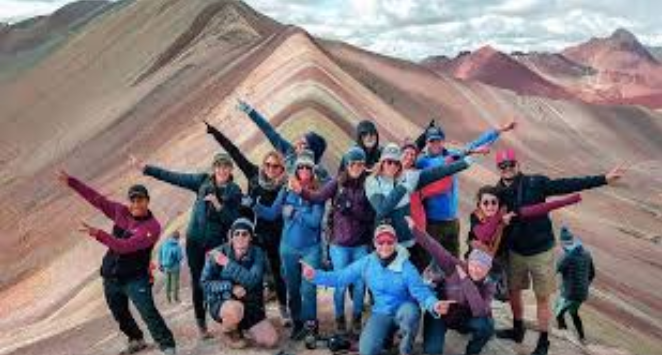Nestled in the heart of the Peruvian Andes, Rainbow Mountain—known locally as Vinicunca or Montaña de Siete Colores (Mountain of Seven Colors)—has emerged as one of South America’s most breathtaking natural wonders. This geological masterpiece, with its striking bands of red, yellow, turquoise, and lavender, has captivated travelers and geologists alike since its relatively recent discovery as a tourist destination. What makes this mountain truly extraordinary is not just its visual splendor, but the fascinating story written in its colorful layers, spanning millions of years of Earth’s history.
The Science Behind the Spectacle
The mesmerizing colors of Rainbow Mountain are not the result of paint or artificial intervention, but rather a spectacular display of natural mineralogy. Each vibrant stripe represents different sedimentary layers that have been exposed through millions of years of geological processes. The red and pink hues come from iron oxide, creating rust-colored bands that dominate much of the mountainside. Yellow tones indicate the presence of sulfur compounds, while the distinctive turquoise and green streaks result from copper sulfate weathering. The white sections contain sandstone and limestone, and the deeper purple and maroon layers reveal a mixture of clay and phyllites rich in various minerals.
These layers were formed during different geological periods, with sediments accumulating over approximately 65 million years. The Andes mountain range, formed by the collision of tectonic plates, pushed these sedimentary layers upward and tilted them at dramatic angles. Weathering and erosion, accelerated by the harsh mountain climate, have stripped away the overlying rock to reveal this natural rainbow beneath.
A Hidden Wonder Revealed
What makes Rainbow Mountain’s story even more remarkable is that this colorful spectacle remained hidden beneath glacial ice until recent decades. Climate change has caused the glaciers that once covered Vinicunca to retreat significantly, gradually exposing the painted mountainside to the world. Local communities had known about the mountain for generations, but it wasn’t until around 2015 that it gained international attention and became a major tourist attraction.
This recent accessibility has transformed the area dramatically. What was once a quiet, remote region visited by few has become a must-see destination for adventurers and nature enthusiasts from around the globe. The transformation has brought both opportunities and challenges to the local communities who call this harsh, high-altitude environment home.
The Journey to the Summit
Reaching Rainbow Mountain is no casual stroll. The trek typically begins from the small village of Pitumarca, located approximately three hours from Cusco, the ancient Incan capital. Most visitors start their journey in the pre-dawn hours, driving through winding mountain roads that offer glimpses of traditional Andean villages and pastoral landscapes where alpacas and llamas graze freely.
The hike itself covers roughly five kilometers (three miles) one way, but the challenge lies not in the distance but in the altitude. Rainbow Mountain peaks at approximately 5,200 meters (17,060 feet) above sea level, placing it well into the realm where altitude sickness becomes a serious concern. The thin air makes each step feel laborious, and even the fittest hikers find themselves stopping frequently to catch their breath.
The trail ascends gradually at first, passing through valleys where local herders tend their livestock. Traditional thatched-roof houses dot the landscape, and visitors often encounter friendly locals dressed in vibrant traditional clothing, offering to pose for photographs in exchange for small tips. As the elevation increases, vegetation becomes sparse, and the landscape transforms into a barren, otherworldly terrain of rocky slopes and distant snowcapped peaks.
Cultural Significance and Community Impact
For the indigenous communities living in the shadow of Vinicunca, the mountain holds deep spiritual significance. The Andean worldview, or cosmovisión, considers mountains to be Apus—sacred spirits that protect and provide for the people. Rainbow Mountain is revered as a particularly powerful Apu, and traditional offerings are still made to honor its spirit.
The tourism boom has brought substantial economic benefits to these communities, which historically relied on subsistence farming and herding. Local families now operate as guides, rent horses for visitors who struggle with the altitude, and sell handicrafts and refreshments along the trail. The income has improved living standards, funded education for children, and reduced the need for young people to migrate to cities for work.
However, this rapid development has also created concerns. The sheer volume of visitors—sometimes thousands per day during peak season—has put pressure on the fragile mountain ecosystem. Erosion from foot traffic threatens to damage the colorful slopes, and waste management remains an ongoing challenge. Community leaders and tour operators are working to implement sustainable tourism practices, including designated paths, visitor limits, and enhanced conservation efforts.
Best Time to Visit and Practical Considerations
The optimal window for visiting Rainbow Mountain extends from May through September, during Peru’s dry season. During these months, clear skies dramatically enhance the vibrant colors, and trail conditions are more manageable. The wet season, from November to March, brings frequent rain and snow, which can obscure the colors and make the trek treacherous.
Proper acclimatization is crucial. Visitors should spend at least two to three days in Cusco or the Sacred Valley before attempting the trek, allowing their bodies to adjust to the altitude. Symptoms of altitude sickness—headaches, nausea, dizziness—should never be ignored. Many tour operators provide coca tea and oxygen bottles as preventive measures.
The weather at high altitude is notoriously unpredictable. Even during the dry season, temperatures can swing from pleasant warmth in the sun to freezing conditions within minutes when clouds roll in. Layered clothing, waterproof jackets, sun protection, and sturdy hiking boots are essential. The intense UV radiation at this elevation can cause severe sunburn in surprisingly short periods.
Alternative Perspectives: Palccoyo
For those concerned about the challenging altitude or seeking a less crowded experience, Palccoyo offers an intriguing alternative. This lesser-known rainbow mountain site features similar geological formations with stunning color displays, but the highest point reaches only 4,900 meters (16,076 feet)—still high, but more manageable for many visitors. The trail is shorter and less strenuous, and the area sees far fewer tourists, offering a more intimate encounter with the landscape.
Palccoyo also provides the unique opportunity to see a stone forest—unusual rock formations that add another dimension to the geological wonders of the region. While Rainbow Mountain (Vinicunca) remains more famous and arguably more dramatic, Palccoyo demonstrates that the Peruvian Andes hold multiple examples of these colorful geological marvels.
Photography and Preservation
Rainbow Mountain has become an Instagram sensation, with countless photographers seeking to capture its otherworldly beauty. The best photographs typically occur in early morning light, when the sun illuminates the slopes with warm, golden rays that intensify the colors. The contrast between the colorful mountain and the bright blue sky creates images that almost seem too vivid to be real.
Yet this popularity raises important questions about preservation. How do we balance the desire to share and experience natural wonders with the responsibility to protect them? The answer lies in conscious, sustainable tourism—following designated trails, packing out all waste, respecting local customs, and supporting businesses that prioritize conservation.
Conclusion: Key Takeaways
Rainbow Mountain stands as a testament to Earth’s artistic power, a natural canvas painted over millions of years through geological processes that continue to shape our planet. Its emergence from beneath retreating glaciers serves as a visible reminder of climate change’s impact, while its popularity demonstrates humanity’s enduring fascination with natural beauty.
For visitors, several key points deserve emphasis: proper acclimatization is not optional but essential for safety; the local communities are partners in preserving this wonder, not merely service providers; the mountain’s fragility demands responsible behavior from every visitor; and the experience transcends the destination photograph—it’s about witnessing geology in action and connecting with the raw power of the Andes.
Rainbow Mountain challenges us physically at altitude while rewarding us with one of nature’s most spectacular displays. It reminds us that our planet still holds secrets and surprises, that beauty exists in the most remote corners of the world, and that sometimes the most extraordinary experiences require genuine effort to achieve. As this geological wonder continues to attract global attention, the ongoing challenge remains finding harmony between accessibility, preservation, and respect for the communities who have lived in its shadow for generations. In Rainbow Mountain, we see not just a tourist attraction, but a living lesson in geology, climate, culture, and the delicate balance required for sustainable coexistence with our planet’s natural treasures.

